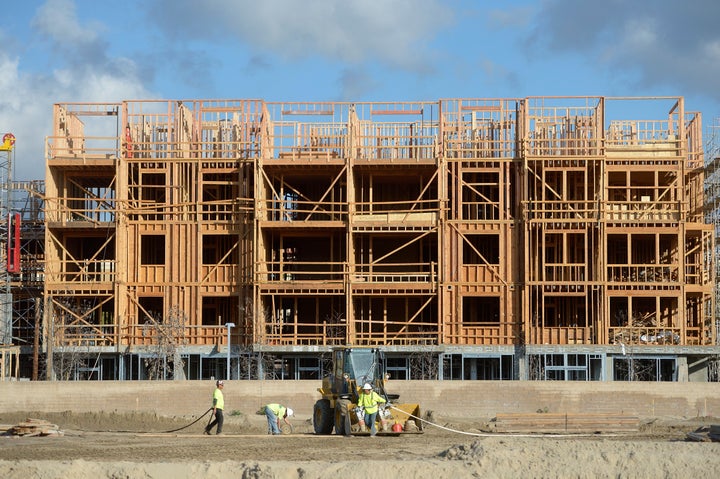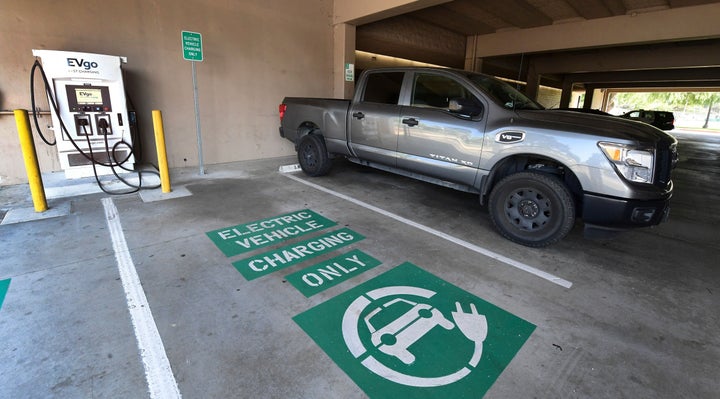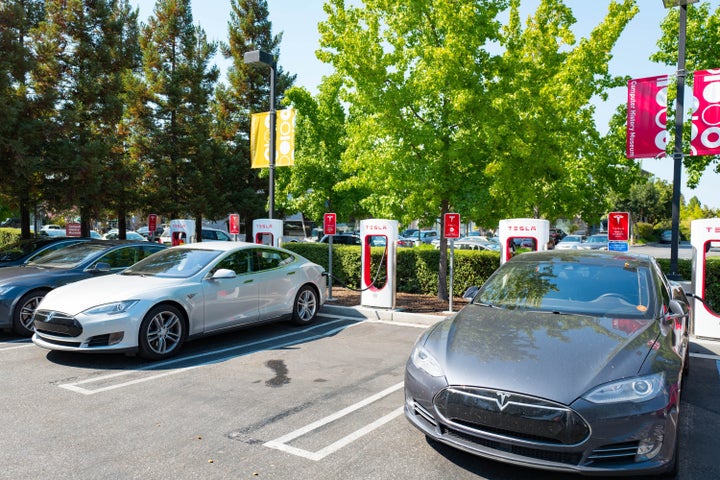
Blessed with scenic Pacific coast drives and cursed with smothering smog and drought-fueled wildfires, California was primed to lead the transition away from the internal combustion engine. Nearly half of the electric vehicles sold in the United States each year are sold in the Golden State.
But if you’re among the millions of Californians who live in an apartment or condo complex, swapping a gas-powered automobile for an electric one can be a challenge.
That’s because the state requires just 10% of parking spaces in multifamily garages to include the circuitry needed to set up an electric vehicle charger. Only a fraction actually have the outlet and equipment needed to plug a car in, so a renter would need their landlord to hire an electrician to complete the setup if they actually wanted to use it.
Now the state agency that sets building codes wants to require 40% of spaces to have at least that basic infrastructure and 5% of those to have the full suite of equipment and wiring needed to service an electric vehicle.
But electric vehicle advocates say the state’s proposal doesn’t go far enough, as it would leave the vast majority of residents in multifamily units ― the fastest-growing type of residence in a state whose population infamously outstrips available housing ― without access. And, they argue, it risks slowing the adoption of those vehicles in the next five years, which is when state and federal policymakers have said they should dominate new car sales.
The California Department of Housing and Community Development’s advisory committee recommended that 100% of newly built housing complexes that have parking include at least one space with the equipment to charge an electric car per unit. But the department rejected that proposal and instead moved forward with the 40% figure late last month.
“California doesn’t need more parking, but whatever parking we have should be electrified.”
- Vanessa Warheit, EV Charging Access for All
Real estate developers pushed for the lower figure, claiming that demand for charging is too low to justify the cost. Electric automakers and advocates also disagreed on how best to accommodate electric vehicle drivers’ charging habits. Building industry groups demanded a looser mandate, and electric vehicle manufacturers prefer fewer spaces equipped with higher-voltage, faster charging rather than universal access with slower charging.
Regulators see the increase they did propose as significant progress.
But the building codes designed today won’t come into force until 2023. Given the time it takes to build, inspect and rent new apartment buildings, it won’t affect real lives and car-buying decisions until 2025 at the earliest.
By then, the International Energy Agency projected in a landmark report this month, the world needs to be just 10 years away from ending all sales of gas-powered automobiles ― or else doom the planet to warming past 1.5 degrees Celsius, an average that spells catastrophic changes. Housing that isn’t designed for that electrified future will require costly retrofits down the road.
It’s an equity problem, too. Tenants in multifamily units are disproportionately Black and Latino, groups that struggle to buy homes in a state where single-family houses make up two-thirds of residences, real estate industry data show. And the state has required builders to equip 100% of new single-family housing with charging circuitry for the past six years.
“More people of color live in multifamily housing, so it’s quite frankly appalling that our state agencies charged with building better housing and ensuring we have clean air to breathe are propping up this structurally racist inequity,” said Vanessa Warheit, an El Cerrito resident who helped lead a statewide coalition of advocates called EV Charging Access for All. “California doesn’t need more parking, but whatever parking we have should be electrified.”
An Emerging Theater In The Climate War
Automobiles produce 29% of emissions in the U.S., representing the single largest contributor, according to Environmental Protection Agency data. Residential and commercial buildings’ heating systems and cooking appliances take up another 15%. When you combine electricity, gas and other variables, buildings use about 40% of the energy consumed in the U.S. and produce a similar portion of greenhouse gases, according to the nonprofit Alliance to Save Energy.
It’s a problem cities and townships are scrambling to rein in with tighter energy-efficiency rules and more renewable electricity. But there’s only so much they can do. Some building codes are governed locally, others at the state level. And a municipality can only go so far. If it becomes too expensive to build in one town, businesses and homebuyers may choose to relocate to a neighboring jurisdiction rather than comply with regulations.
In 2019, municipalities across the country tried to remedy the problem through the International Code Council, or ICC, the nonprofit consortium of local governments and industry that designs model building codes used in all 50 states. Hundreds of counties, cities and towns that year rallied to vote in favor of building codes that mandated circuitry for electric vehicles and appliances and that required insulation that significantly ramped up energy savings.
But the vote drew a fierce backlash from groups representing home builders and gas utilities. The trade associations accused city governments of making irresponsibly ambitious demands of the model energy code. In February, the ICC submitted to the pressure and eliminated cities’ right to vote on future codes altogether, despite opposition from environmentalists, local governments, and the Biden administration.
In response, cities vowed to create stricter codes anyway, the ICC’s model codes be damned. That has left them looking for a new national model. Requiring that every unit in a multifamily housing complex have access to electric vehicle charging would make California that model.

“A win for 100% of dwelling units to be able to have an electric vehicle would be a gamechanger,” said Kim Cheslak, director of the advocacy group the New Buildings Institute. But just aiming for 40% in California is “probably not going to impact the way we talk about this as we move across the other 49 states.”
As at the ICC, construction and real estate players appear to be among the biggest opponents to making charging universally accessible.
At a public hearing last month, a landlord at a multifamily complex who gave his name as Marshall said electric vehicles aren’t widely used enough to merit the cost of making charging universally available, which would likely be passed along to residents.
“I don’t want us to get too far out over our skis,” he said, according to a transcript of the hearing. “The number of total cars on the road that require plug-in by the time 2035 rolls around, it will increase, but it still won’t be a one-to-one, or even close.”
A Debate Over Which To Prioritize: Volts Or Cars
People who are lowballing future demand for electric vehicles aren’t the only ones opposed to charging for every housing unit. Electric automakers came out against a proposal that would make charging available to all but only require Level 1 outlets, the sort of three-pronged receptacles in which you’d plug a mobile phone or a toaster.
At 120 volts, those outlets charge an electric vehicle at a rate of about four miles of range per hour, meaning a vehicle plugged in overnight can charge enough for the daily commute, but not enough to charge a fully depleted battery.
Carmakers instead called for universal access to Level 2 charging. At 240 volts, these outlets ― the same kind into which you’d plug a clothes dryer ― charge an electric vehicle six times faster and are what you typically see powering cars in the parking lots of a library or Whole Foods.
In a letter to the Department of Housing and Community Development, the Alliance for Automotive Innovation, an industry group whose members include Ford, General Motors and Ferrari, urged the regulators to “adopt codes that require 100% of total parking spaces in new multi-unit dwellings” to be ready to plug in electric vehicles, but recommended the code mandate Level 2 charging.
Advocates of making charging universal say Level 2 charging would be nice, but significantly more expensive, and would largely serve an nonexistent need.
“The No. 1 concern is more access, the No. 2 concern is how expensive it is to deploy EV charging,” said Rafael Reyes, the director of energy programs at Peninsula Clean Energy, a publicly owned nonprofit that provides electricity to San Mateo County, the more rural stretch of Bay Area coast south of San Francisco.
The agency’s 40% proposal represented “the worst of all possible worlds,” he said, because it includes a hodgepodge of Level 1 and Level 2 while providing so few units with ready-to-go charging.
“It’s very complicated and it’s more expensive to build than our proposal, which gives everybody access,” Reyes said.
“A win for 100% of dwelling units to be able to have an electric vehicle would be a gamechanger.”
- Kim Cheslak, director of the advocacy group the New Buildings Institute
What frustrates Reyes and other electric vehicle drivers is what they see as a misunderstanding of the natural habits that form once you own a plug-in car. Charging an electric vehicle is much more similar to powering an iPhone than refueling a traditional automobile. Rather than filling up the gas tank once a week or so, drivers typically plug an electric vehicle in each night and top off, rarely depleting the battery beyond what a slow overnight charge could restore, according to a letter from hundreds of electric vehicle owners who boast a combined 3,400 years of driving zero-emissions vehicles.
“Electric cars are very efficient, and most new models have enough range to satisfy the needs of a typical driver for multiple days without charging,” Consumer Reports concluded in its December 2020 guide to buying an electric car. “For most drivers, this means daily energy usage can be replenished from a simple 110-volt outlet, without the need to purchase and install a 240-volt Level 2 charger.”
Reducing access to charging for all to allow for faster charging for some represents “incrementalism at a time when we need a huge leap forward,” said state Sen. Josh Becker, a Democrat representing the Silicon Valley area.
“Nobody’s going to buy EVs unless they have reliable access to charging at home,” he said.
Still, the Department of Housing and Community Development said the “many stakeholders who participated in” its focus group meetings “preferred more powerful Level 2 chargers.”

“This is better for people with longer commutes and [who] own EV’s with larger batteries, or those who don’t have 12 or more hours to charge their vehicle and get where they need to go,” Kyle Krause, the agency’s deputy director of codes and standards, said in an emailed statement sent through a spokesperson.
About 80% of electric vehicle charging happens at home, according to Department of Energy statistics. Yet some in the industry seem to be betting on a future where electric vehicle charging does in fact look more like refueling an internal combustion engine. The fast-charging stations that companies like Tesla and EV Go operate represent a third type of charging that can fill an electric vehicle battery in 30 minutes or less.
Tesla said by email that it “doesn’t speak with press for stories,” but forwarded a letter it sent to the California Building Standards Commission, the agency that sets nonresidential codes, advocating for the expansion of “publicly accessible, easy-to-use charging stations.”
Will Michigan Lead Where California Stumbles?
The disparate demands shaping the future of electric vehicle infrastructure highlight the “patchwork that’s happening across the country,” Cheslak said.
“Even though you’d think they’d be relatively standard as you move from jurisdiction to jurisdiction, there’s a patchwork even across California right now,” she said.
Absent a jolt from California’s code, Michigan’s own building codes on electric vehicles, scheduled for debate later this year, could offer advocates and policy experts another chance to set a new national model, Cheslak added.
With hopes dimming that the ICC’s code, now more firmly in the hands of industry groups, can dictate changes at the speed required to keep global warming in check, some advocates say they may turn to the federal government to intervene with new regulations.
“California is failing to be a leader,” said Sven Thesen, a chemical engineer and electric vehicle policy consultant who advocated for the 100% charging code in multifamily housing. “The federal government has an opportunity here to change building codes to represent the actual behavior of EV drivers.”

